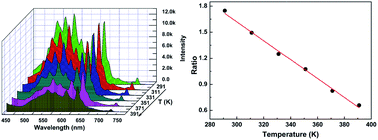Sr1.7Zn0.3CeO4F0.2:Eu3+: novel dual-emission temperature sensors for remote, noncontact thermometric application†
Abstract
A novel dual-emitting temperature sensor, Sr1.7Zn0.3CeO4F0.2:Eu3+, is successfully synthesized via a ceramic reaction. Powder X-ray diffraction patterns and Rietveld refinement verify the phase purity of the sensor. Its photoluminescence spectrum exhibits a pronounced intrinsic dual emission, theoretically divided by the wavelength of 570 nm: one stems from Eu3+ and the other is derived from the Ce4+–O2− charge transfer state. The temperature-dependent luminescence spectra of the dual-emission thermophosphor demonstrate its superior sensitivity towards ambient temperature. Further studies illustrate that the intensity ratio between the aforementioned two parts, as a function of temperature, is perfectly linear over a broad temperature window, yielding a convenient and accurate approach to obtain the temperature of a target, measured using the noncontact self-referencing model. We also investigate the basis of the underlying mechanism of Sr1.7Zn0.3CeO4F0.2:Eu3+ as a dual-emission thermometric sensor. The research herein shows that the intrinsic dual-emission sensor, as a new-fashioned thermophosphor, displays potential for ratiometric intensity measurements in thermometry domains.



 Please wait while we load your content...
Please wait while we load your content...